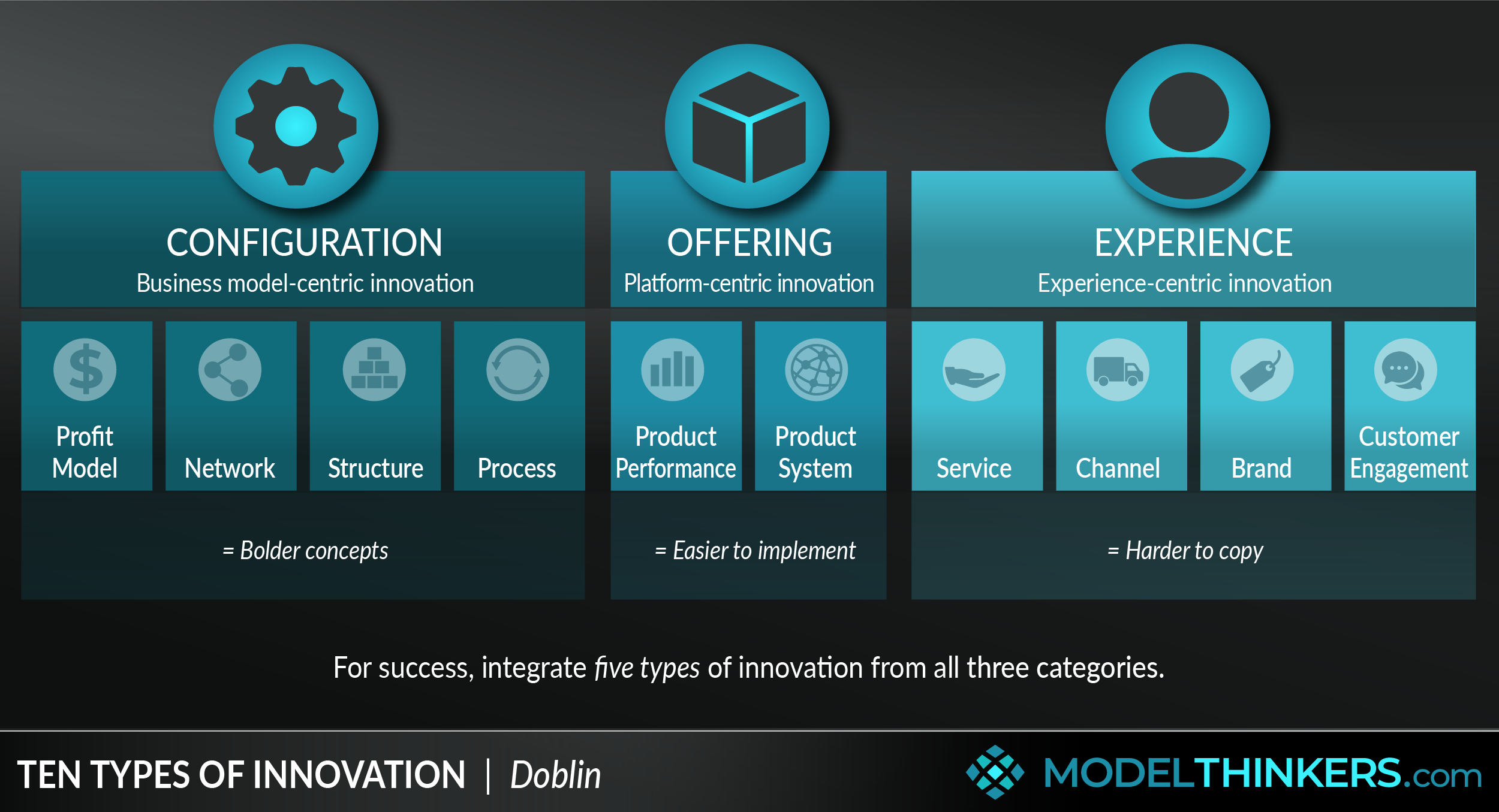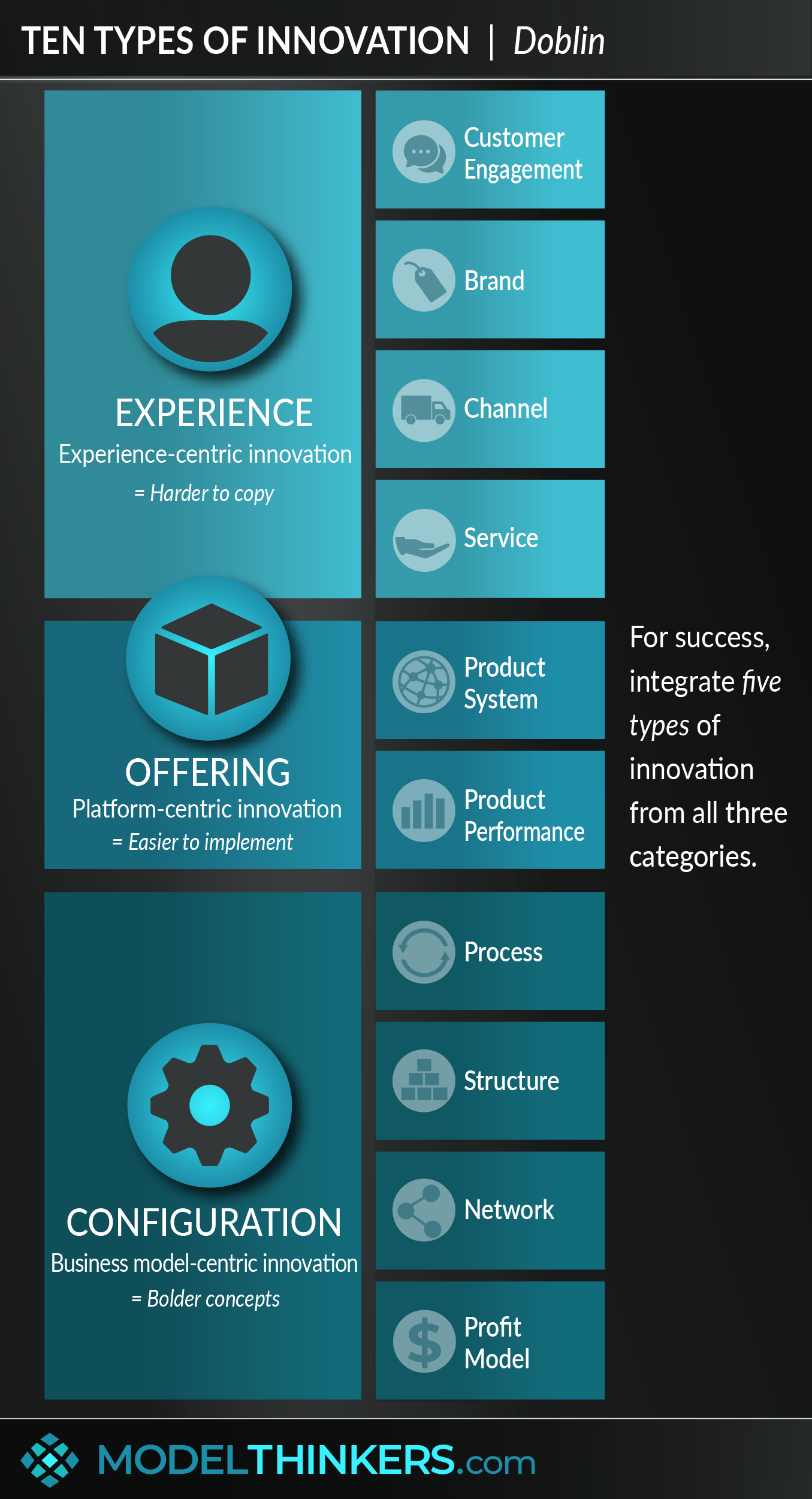

 0 saved
0 saved
 10.6K views
10.6K views








Thinking about business innovation will generally lead you to imagine ground-breaking new products or product features. However, according to this model, a product inspired approach is only one of ten potential areas of innovation.
Ten Types of Innovation is a diagnostic and analysis framework that can support greater innovation by encouraging a broad view across Configuration, including internal business factors; Offering, including product performance and product systems; and Experience, including service and customer engagement.
THE TEN ELEMENTS.
The framework presents as a ‘periodic table for innovation’, with ten elements falling under three high-level categories Those elements are:
|
ELEMENT |
AT A GLANCE |
INNOVATION INVOLVES |
EXAMPLE |
|
CONFIGURE |
|||
|
Profit Model |
How you make money. |
Finding fresh value sources and potential revenue, challenging assumptions about what to charge, or even how to collect revenue. Ask: 'How might I generate income from an alternative source to what's expected?' |
Gillette initially selling expensive razors, shifting to cheap razors with expensive refills. |
|
Network |
How you connect with others to create value. |
Finding new ways to use other companies’ processes, technologies, offerings, channels and brands. It’s about key partnerships and collaboration. Ask: 'What partnerships will complement my offer?' |
Atlassian partnering with Slack to help create a work-based ecosystem for teams. |
|
Structure |
How you align assets and talent. |
Re-organising company assets and human resources, including better talent management systems to structural changes to reduce fixed costs. Ask: 'If we were starting from scratch, how would we organise to best deliver impact?' |
Google implemented a 20% rule, allowing staff to work on side projects leading to Gmail and Google News. |
|
Process |
How you get work done. |
Embracing new methods and processes to better capitalise on core competencies of an enterprise. Ask: 'What new method will help to double our impact?' |
Tesla vertically integrated its supply chain to lower the price of batteries by up to 30%. |
|
OFFERING |
|||
|
Product performance |
How you distinguish features and functionality. |
New products and/or updates and improvements to existing products. Most common approach but is generally easy to copy. Ask: 'How might our product/service better delight our customer?' |
Spotify turned the music industry upside down by delivering digital access, disrupting CD and traditional markets. |
|
Product System |
How you offer complementary products and services. |
Changing how products and services are bundled to create systems and value-based ecosystems. Ask: 'What's the product ecosystem that we are aiming to create?' |
Microsoft is building out their Office suite to incorporate Teams and now Microsoft Viva, for a full work ecosystem. |
|
CUSTOMER EXPERIENCE |
|||
|
Service |
How you support and amplify your offer’s value. |
Enhancing the utility and performance of an offer by making it easier to use, highlighting features and supporting the customer experience. Ask: 'How might our service become part of our value proposition?' |
Mercedes launched an augmented reality app to replace the traditional manual. |
|
Channel |
How you deliver to customers. |
Including improving eCommerce and/or immersive physical experiences. Reducing friction to purchase. Ask: 'How might we better deliver to our customers in a way that works best for them?' |
Dollar Shaver Club offers a subscription model of replacement razors delivered to your door. |
|
Brand |
How you represent your business and offer. |
Developing a ‘promise’ that attracts buyers through advertising, communication and service interaction. Ask: 'How might we better build our brand promise with our audience?' |
Whole Foods has been ranked as the most trusted brand in the US, promising healthy products. |
|
Customer Engagement |
How you foster connection and community. |
Understanding customer aspirations and developing meaningful connections. Ask: 'How might we build and invigorate an active community?' |
Peloton providing virtual social exercise opportunities, running gym classes at home. |
FINDING THE BOLD, EASY & UNIQUE.
Doblin, the innovation firm and creators of this framework, argue that the usual focus on product innovation is one of the easiest types of innovation to copy by competitors. It’s important, but cannot be solely relied upon to create a viable business.
They point to the configuration elements as being ‘bold’ and often disruptive approaches, with the experience elements tending to be more challenging for competitors to copy.
COMBINE ELEMENTS TO SUCCEED.
Based on their research, Doblin advocates focusing on at least five of the elements and ensuring that those elements draw from each of the three categories of configuration, offering and experience.
Larry Keeley, from Doblin, argues that leading tech companies today have not achieved their success through technology per se. He cites examples such as Airbnb or Uber which have a tech stack over up to 100 technologies, with only a handful of proprietary software or approaches.
Further, those proprietary technologies are easily replicated. Such companies success, Keeley argues, is their approach of drawing from at least five of the innovation elements across the three categories. See the Airbnb case study in the In Practice section below for more.
IN YOUR LATTICEWORK.
Ten Types of Innovation is a useful framework for any organisation or business to measure, track and broaden its approach to innovation. As such, it's a strong companion with innovation models such as Design Thinking and Framestorming.
The framework can be used as a powerful business strategic tool to create lasting points of difference which helps to address the challenges posed by models such as the Red Queen Effect and Blue Ocean Strategy.
Application of the Ten Types of Innovation could also be more impactful with an understanding of competitors using models such as Porter’s Five Forces. On a diagnostic level, consider adding an innovation perspective to the Balanced Scorecard and carrying out further innovation Benchmarking.
Finally, use First Principles to help move beyond more obvious product-centric innovation and challenge the way you configure your business and/or your customers experience.




-
Move beyond product-centric innovation.
When driving business innovation, look beyond your product and product features and consider the entire landscape of innovation potential from configuration to engagement. This is particularly important when striving for a lasting competitive difference that will be hard to replicate.
-
Use Ten Types of Innovation to measure, direct and improve innovation.
Doblin advocates using their framework as a diagnostic tool for business units and combining it with KPIs to drive innovations across the different types of innovation categories. This might include a scorecard for executives, bonuses, awards and other campaign elements.
-
Innovate around configuration.
Challenge your assumptions around how your business operates, what drives its profit model, how it's structured and the processes you are using. This is often the hardest, most boldest area to innovate in and might require the application of First Principles.
- Innovate around your offering.
The obvious element here is the product itself. And creating a better more surprising and delightful product is important. But, in addition, consider your product ecosystem and the system you are creating to deliver a holistic experience.
- Innovate around customer experience.
Consider the customer experience from service, channel, brand and engagement. How are you creating communities? How might your customer touchpoints be improved or thrown on its head to create a better experience?
Ten Types of Innovation is a useful framework for measuring and broadening the potential focus areas for innovation, though the ‘formula’ that every business requires ‘at least five elements over three categories’ might be challenged as a matter of interpretation rather than a required fact.
In addition, when implemented as a diagnostic tool to drive innovation the framework might lead to breadth over depth. That is, trying to cover a range of innovation areas rather than diving deeply into a handful of the elements for greater impact.
Airbnb.
Larry Keeley from Doblin often cites the example of Airbnb as a major innovative success story.
Airbnb of course has disrupted traditional hotel, motel and accommodation businesses by delivering a platform with no real estate. With the platform focus, you might think that Airbnb is a technological breakthrough, though Keeley points out that of the 57 technologies in its tech stack there are approximately 7 proprietary ones. See the slide below from Doblin.
The point? These technologies are available to anyone and the 7 that are not are relatively easy to replicate.
Their innovative genius, Keeley points out, is not in the technology, it’s in their broader innovation focus. Another slide from Doblin:
As can be seen from the slide, Doblin’s analysis has identified that AirBnB has innovated across five elements that span all three categories — thus sticking to Doblin’s recommended formula based on their research.
c
Ten Types of Innovation was developed by Doblin, a Chicago based innovation firm that has since been purchased by Deloitte.
The framework was developed by researching over 2,000 business innovations during the 1980s and has since been validated by their ongoing work in the area.
Doblin describes the model on their website and, in 2013, published a book on the topic. If you want to dig deeper into this framework, be sure to view Doblin's Ten Types of Innovation Tactics Overview which outlines specific tactics that can be applied to innovate for each element.
 My Notes
My Notes
Oops, That’s Members’ Only!
Fortunately, it only costs US$5/month to Join ModelThinkers and access everything so that you can rapidly discover, learn, and apply the world’s most powerful ideas.
ModelThinkers membership at a glance:






“Yeah, we hate pop ups too. But we wanted to let you know that, with ModelThinkers, we’re making it easier for you to adapt, innovate and create value. We hope you’ll join us and the growing community of ModelThinkers today.”






